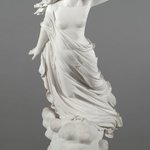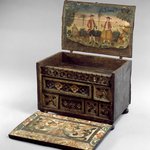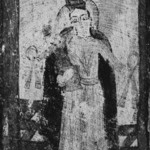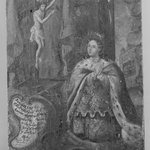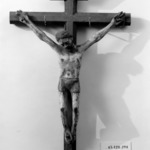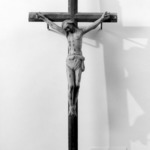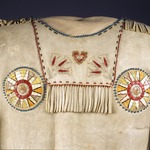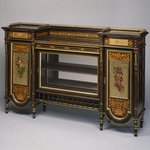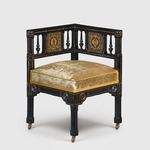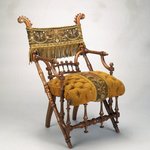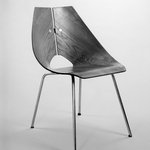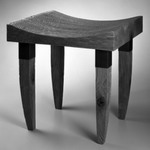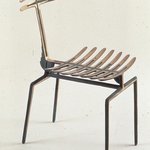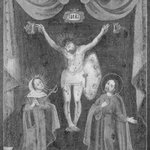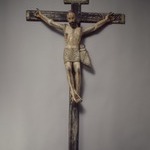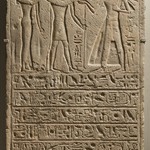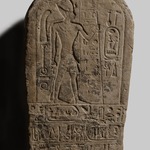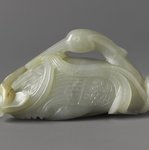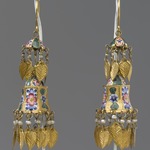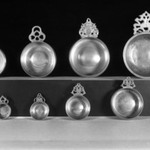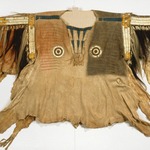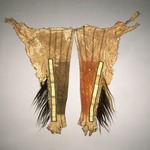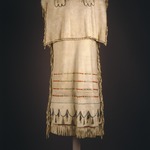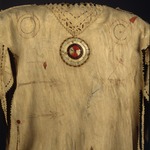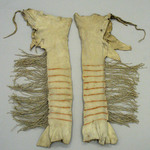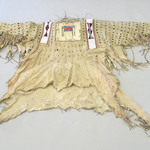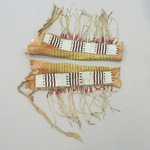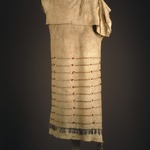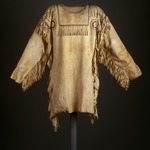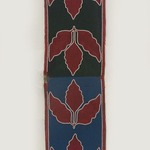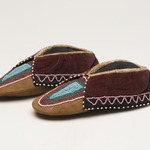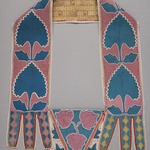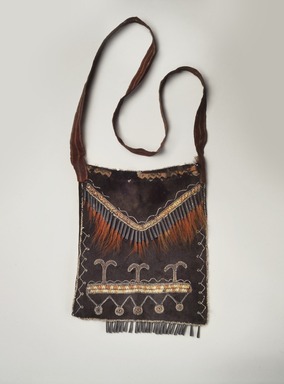

Delaware. Black Pouch, late 18th–early 19th century. Buckskin, porcupine quills, tin, deer hair, ribbon, glass beads, commercial cloth, 10 x 8 1/2 in. (25.4 x 21.6 cm). Brooklyn Museum, Henry L. Batterman Fund and the Frank Sherman Benson Fund, 50.67.15. Creative Commons-BY (Photo: Brooklyn Museum, 50.67.15_edited.jpg)

Delaware. Black Pouch, late 18th–early 19th century. Buckskin, porcupine quills, tin, deer hair, ribbon, glass beads, commercial cloth, 10 x 8 1/2 in. (25.4 x 21.6 cm). Brooklyn Museum, Henry L. Batterman Fund and the Frank Sherman Benson Fund, 50.67.15. Creative Commons-BY (Photo: Brooklyn Museum, 50.67.15_acetate_bw.jpg)
Black Pouch
Arts of the Americas
THE JARVIS COLLECTION
The articles in this case and the adjacent clothing case [see 50.67.6] are some of the earliest and finest Eastern Plains pieces in existence. They were collected by Dr. Nathan Sturges Jarvis, a military surgeon stationed at Fort Snelling, Minnesota, between 1833 and 1836. Most items were made by the Eastern and Middle Dakota (Sioux) or by the peoples of the Red River region, including the Red River Métis, Anishinabe, Plains Cree, and Salteaux. Some of the objects were purchased by Jarvis, and others may have been given to him in exchange for his medical services.
By the early nineteenth century, the growing numbers of white settlers and military personnel—following decades of fur trading—had depleted much of the game on which the Dakota and Red River peoples depended. Indigenous ingenuity in combining trade materials such as cloth, metal, and glass beads with traditional hides, pipestone, and porcupine and bird quills is evident in these objects.
The articles in this case and the adjacent clothing case [see 50.67.6] are some of the earliest and finest Eastern Plains pieces in existence. They were collected by Dr. Nathan Sturges Jarvis, a military surgeon stationed at Fort Snelling, Minnesota, between 1833 and 1836. Most items were made by the Eastern and Middle Dakota (Sioux) or by the peoples of the Red River region, including the Red River Métis, Anishinabe, Plains Cree, and Salteaux. Some of the objects were purchased by Jarvis, and others may have been given to him in exchange for his medical services.
By the early nineteenth century, the growing numbers of white settlers and military personnel—following decades of fur trading—had depleted much of the game on which the Dakota and Red River peoples depended. Indigenous ingenuity in combining trade materials such as cloth, metal, and glass beads with traditional hides, pipestone, and porcupine and bird quills is evident in these objects.
CULTURE
Delaware
MEDIUM
Buckskin, porcupine quills, tin, deer hair, ribbon, glass beads, commercial cloth
DATES
late 18th–early 19th century
DIMENSIONS
10 x 8 1/2 in. (25.4 x 21.6 cm) (show scale)



COLLECTIONS
Arts of the Americas
ACCESSION NUMBER
50.67.15
CREDIT LINE
Henry L. Batterman Fund and the Frank Sherman Benson Fund
PROVENANCE
Prior to 1848, provenance not yet documented; by 1848, acquired by Nathan Sturges Jarvis; 1848, gift of Nathan Sturges Jarvis to the New-York Historical Society, New York, NY; 1937, loaned by the New-York Historical Society to the Brooklyn Museum; 1950, purchased from the New-York Historical Society by the Brooklyn Museum.
Provenance FAQ
CATALOGUE DESCRIPTION
Dyed black deerskin pouch decorated with a false flap, a modified "V" shaped line that is elaborated to seem like the opening of the bag. The edge of this "flap" is bordered with braided quill work in stripes of orange and blue, edged at the top and bottom of the border with thin white lines. A thin, undulating white line has been embroidered above this border. From the bottom of the border, enhancing this illusion of a flap, metal cones filled with reddish deer hair are suspended. Similar cones with deer hair are suspended from the bottom of the bag.
The bottom half of the bag is embroidered with quills in a complex of motifs. Three double-curved forms or bifurcating lines are embroidered with thin lines or orange, blue and white. These forms "sprout" from a wider double band of orange and white braided quill work, elaborated with thin outlines in blue and white. The border or groundline for these sprouting forms is surrounded by an irregular, zig-zag outline in white with some blue at bottom. At the base of each of the five resulting points of the zig-zag are five circles, each composed of concentric rings made of quill embroidered lines of white, orange and blue.
The ribbon strap of the pouch is now deteriorated, appearing to be maroon with yellowish stripes.
MUSEUM LOCATION
This item is not on view
CAPTION
Delaware. Black Pouch, late 18th–early 19th century. Buckskin, porcupine quills, tin, deer hair, ribbon, glass beads, commercial cloth, 10 x 8 1/2 in. (25.4 x 21.6 cm). Brooklyn Museum, Henry L. Batterman Fund and the Frank Sherman Benson Fund, 50.67.15. Creative Commons-BY (Photo: Brooklyn Museum, 50.67.15_edited.jpg)
IMAGE
overall, 50.67.15_edited.jpg. Brooklyn Museum photograph
"CUR" at the beginning of an image file name means that the image was created by a curatorial staff member. These study images may be digital point-and-shoot photographs, when we don\'t yet have high-quality studio photography, or they may be scans of older negatives, slides, or photographic prints, providing historical documentation of the object.
RIGHTS STATEMENT
Creative Commons-BY
You may download and use Brooklyn Museum images of this three-dimensional work in accordance with a Creative Commons license. Fair use, as understood under the United States Copyright Act, may also apply.
Please include caption information from this page and credit the Brooklyn Museum. If you need a high resolution file, please fill out our online application form (charges apply).
For further information about copyright, we recommend resources at the United States Library of Congress, Cornell University, Copyright and Cultural Institutions: Guidelines for U.S. Libraries, Archives, and Museums, and Copyright Watch.
For more information about the Museum's rights project, including how rights types are assigned, please see our blog posts on copyright.
If you have any information regarding this work and rights to it, please contact copyright@brooklynmuseum.org.
RECORD COMPLETENESS
Not every record you will find here is complete. More information is available for some works than for others, and some entries have been updated more recently. Records are frequently reviewed and revised, and we welcome any additional information you might have.
